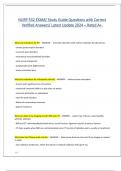NURP 532 EXAM/ Study Guide Questions with Correct
Verified Answers/ Latest Update 2024 – Rated A+.
What are indications for PT? - ANSWER - - traumatic disorders with mild or moderate functional loss
- chronic postural pain disorders
- recurrent pain disorders
- mechanical musculoskeletal disorders
- early nerve entrapment
- symptomatic joint degeneration
- acute unresolved pain
What are indications for orthopedic referral? - ANSWER - - obvious tissue disruption
- trauma with significant loss of function
- continued functional deficit or pain after six weeks
- recurrent dislocation or subluxation
- need for joint injection
- failure of conservative measures
- patient insistence
What can plain X-ray imaging reveal? MRI and CT? - ANSWER - - plain X-ray- fracture, osteomyelitis,
arthritis, infection
- MRI and CT- radiculopathy/pinched nerve, occult fracture, ligament injuries, meniscus injuries
- CT done usually when MRI are contraindicated since CT has lots of radiation and is usually not preferred
What does the Ottawa ankle rule do? - ANSWER - - determines fracture risk and if X-ray images is needed
in ankle
- any malleolus tenderness, either the lateral or medical malleolus then get X-ray
pg. 1
,- pain over the 5th metatarsal or if you have pain in the midfoot and pt is only able to take 4 steps, then
you definitely need imaging of the foot
ABCDE of melanoma - ANSWER - A = asymmetry
B = border irregularity
C = color variation
D = diameter >6mm
E = evolution over time
What is the classic presentation of basal cell carcinoma? does it metastasize? dx? staging 1 vs stage 2? -
ANSWER - - little nodular papule, superficial, infiltrative (tentacles under skin)
- common on nose
- dx- refer to dermatology for further evaluation and bx
- does not metastasize
- stage 1- less than 2cm
- stage 2 - more than 2cm
What is the classic presentation of squamous cell carcinoma? dx? does it metastasize? - ANSWER - - non-
healing lesion, hyper keratotic plaque, poorly defined borders, rodent bite (ulcerated center)
- common on forehead, temples, back of neck, and postauricular cheeks, nose, and lips
- bleeds easily with trauma- open sore that does not heal in 3 weeks
- CLASSIC SIGN- ulcerated center
- dx- refer to dermatology for further evaluation and bx and excision
- does not metastasize
What is the classic presentation of melanoma? dx? can it metastasize? - ANSWER - - asymmetrical,
irregular borders, different colors, diameter >6mm, changing/evolving
- most common is superficial melanoma
pg. 2
,- dx- excisional bx via dermatology referral
- can metastasize to other parts of the body- most aggressive skin cancer
What does melanoma in situ mean? - ANSWER - it has broken skin surface
T/F: BCC is the most common non-melanoma type of skin cancer - ANSWER - true
What conditions can cause generalized red rashes can be accompanied by fever? tx? - ANSWER - - 5th
disease parvovirus- slapped cheeks rash, fever, lacy rash
- measles- morbilliform rash, fever, koplik spots in mouth, rash will start and disappear from head to toe,
will desquamate after
- roseola infantiosum- 6th disease- high fever then rash- caused by human herpes virus 6; begins on
trunk first and then spreads
- erythema multiforme reaction to smallpox vx
- scarlet fever- sore throat, scarlitiniform rash- red and white every with raised goose flesh, pastia lines-
white line at elbow crease
- tx- supportive
What conditions can cause generalized red rash with bullae? tx? - ANSWER - - toxic epidermal necrolysis-
most often from sulfa drug reaction
- stevens johnson syndrome
- bullous pemphigoid- seen in elderly; not as serious as toxic epidermal necrolysis or stevens johnson
syndrome; at risk of infection; long term corticosteroids needed
- THESE ARE EMERGENCY SITUATIONS- can lead to severe dehydration and death- SEND TO ER/ED
T/F: most red rash with bullae are secondary reactions towards sulfa drugs - ANSWER - true
What conditions an cause generalized rash with vesicles? - ANSWER - - disseminated herpes simplex
virus
pg. 3
, - vesicular rash reaction from drug allergy
- herpes zoster- will be along dermatomes/unilateral; not crossing midline
How would you treat herpes zoster? - ANSWER - given antiviral (ideally valacyclovir) ideally within 72
hours of s/sx onset to decrease risk of postherpetic neuralgia
What is urticaria? tx? - ANSWER - - commonly referred to as "hives"; a kind of skin rash notable for pale
red, raised, itchy bumps
- give antihistamines, corticosteroids
- refer to allergy immunology if recurrent
T/F: purpura fulminans puts someone at increased risk of developing DIC; do labs and refer to derm -
ANSWER - true
What does systemic lupus erythematosus commonly look like? - ANSWER - malar rash- butterfly rash on
face
What are common s/sx of psoriasis? psoriatic arthritis vs guttate psoriasis vs inverse psoriasis vs
erythrodermic psoriasis vs pustular psoriasis? - ANSWER - - red, scaly, inflamed rash that forms large
white/silver scaled plaques
- common over knees and elbow
- usually bilateral over extensor surfaces- common sign
- found in places like scalp, buttocks, trunk, sometimes nail involvement (pitting)
- psoriatic arthritis- pitting of nails and sausage fingers; those with scalp psoriasis are at high risk of
arthritic symptoms
- guttate psoriasis- smaller, little tear drop lesions all over body; associated after strep infection
- inverse psoriasis- folds or flexoral surfaces, front of elbows, folds of buttocks
- pustular psoriasis- little pustules on soles of feet and palms of hands; no plaques
What are risk factors of psoriasis? tx? - ANSWER - - risk - stress, acute illness, strep infection- esp guttate
psoriasis, Koebner phenomenon- injury healed into plaque
pg. 4




